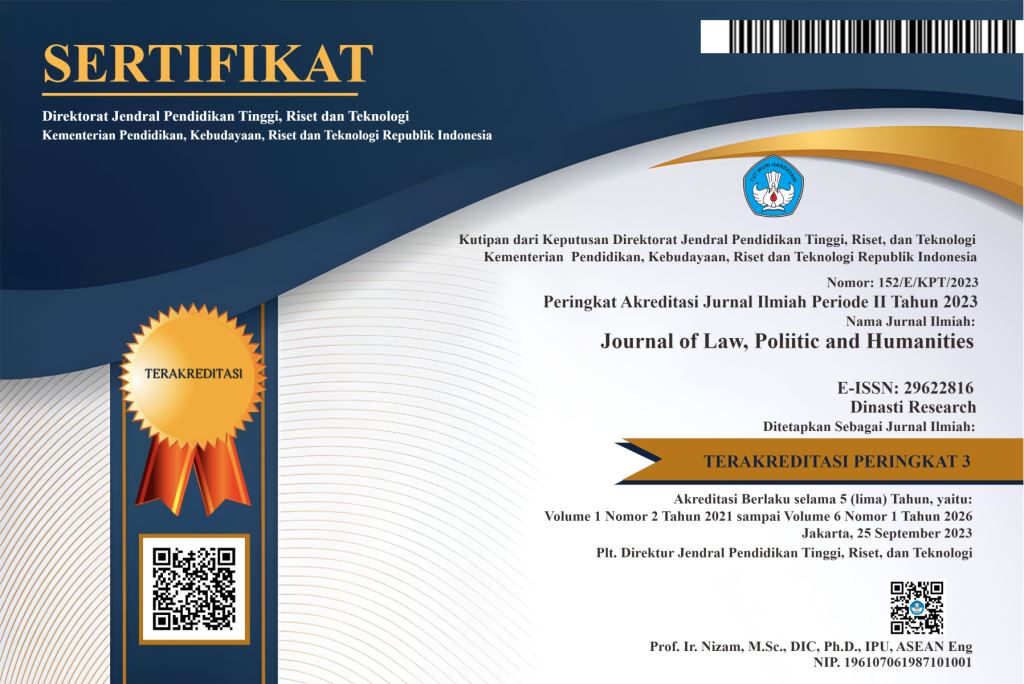Refugee Status Determination in the Contiguous Zone Under International Law
DOI:
https://doi.org/10.38035/jlph.v5i4.1544Keywords:
Refugee, Contiguous ZoneAbstract
According to UNHCR, The state is primarily responsible for determining refugee status within its territory. This means that RSD must be carried out in the country where the asylum seeker applies for protection, as it has full sovereignty and jurisdiction. The problem arises when the coastal state determines and processes the RSD of asylum seekers outside its territory, especially in the Contiguous Zone, where the coastal state only has the authority to conduct surveillance, especially ‘migration controls.’ What is interesting to study is whether the practice of RSD in the Contiguous Zone is legitimate and can be carried out under international law and how RSD in the Contiguous Zone is related to the function of immigration control according to International Law. The methodology used is descriptive, using the approach of international legal instruments and existing cases. From the discussion, it is found that RSD in the contiguous zone can be carried out depending on the interpretation of Article 33 UNCLOS 1982. In addition, it is also explained how the principle of non-refoulement and human rights instruments intersect. It can be concluded that RSD can be conducted in the contiguous zone; non-refoulement is the first form to start RSD.
References
Alan M. F. (2024). The British Hovering Acts: A Contribution to the Study of the Contiguous Zone. Revue Belge de Droit International, 16(2), 434. https://rbdi.bruylant.be/modele/rbdi/content/pdf/rbdi_2016/RBDI%201981-1982.2%20-%20pp.%20434%20a%20458%20-%20Alan%20M.%20Frommer.pdf
Alva, J., & Handayani, I. (2019). Regionalism as a Solution to Refugee Protection in ASEAN. Jurnal Ilmu Hukum (Journal of Law), 2, 379–406. http://dx.doi.org/10.22304/pjih.v6n2.a9.
A.V. Lowe. (1981). The Development of the Concept of the Contiguous Zone. British Yearbook of International Law, 52(1). https://doi.org/https://doi.org/10.1093/bybil/52.1.109
D. R. Rothwell, & T. Stephens. (2010). The International Law of the Sea (Vol. 80). Leiden: Martinus Nijhoff Publishers.
Gammeltoft-Hansen. (2011). International Refugee Law and the Globalization of Migration Control. Access to Asylum.
Georgoula, D. F. (2022). Building Walls at Sea: An Assessment of the Legality of the Greek Floating Barrier. International Journal of Refugee Law, 34(1), 54–81. https://doi.org/10.1093/ijrl/eeac021
Guy S., & Goodwin-Gill. (2014). The International Law of Refugee Protection. In The Oxford Handbook of Refugee and Forced Migration Studies (Elena Fiddian, Vol. 4). Oxford University Press.
Guys S. Goodwin-Gill, & Jane McAdam. (2007). The Refugee in International Law. Oxford: Oxford University Press, 232.
House of Commons Library. (2019). Asylum Statistics. https://researchbriefings.files.parliament.uk/documents/SN01403/SN01403.pdf.
Islam, R., & Bhuiyan, J. H. (2013). An Introduction to International Refugee Law. Belanda: Martinus Nujoff
Jahid Hossain Bhuiyan. (2013). Determination of the Status of Refugees. In An Introduction to International Refugee Law (Vol. 55).
Jamaa, H., & Italy, O. V. (2024). European Court Of Human Right Cour Europeenne Des Droits De L'homme. EDAL (European Database Of Asylum Law)
Kum, S. N. (2024). Maritime Zones (Contiguous Zone) Regulations. Malta: IMO International Maritime Law Institute. https://imli.org/wp-content/uploads/2021/03/Kum_Savita_Drafting.pdf.
Matera, M., Tubakovic, & T. Murray. (2023). Is Australia a Model for the UK? A Critical Assessment of Parallels of Cruelty in Refugee Externalization Policies. Journal of Refugee Studies.
McAuliffe & Oucho, L. A. (2024). About Migration. International Organization for Migration. https://mena.iom.int/sites/g/files/tmzbdl686/files/documents/2024-05/pub2023-047-l-world-migration-report-2024_1.pdf
Molnar, P. (2014). The ‘Bogus’ Refugee: Roma Asylum Claimants and Discourses of Fraud in Canada’s Bill C-31. Refuge, 30(1). Available at SSRN: https://ssrn.com/abstract=2882241.
Ramachandran, N. (2024). The Enforced Destitution of Asylum Seekers in the UK. Journal of Human Rights and Social Work, 9, 139–153. https://doi.org/10.1007/s41134-024-00300-8.
Refugee Council of Australia. (2024). Asylum Boats Statistics. https://www.refugeecouncil.org.au/asylum-boats-statistics/.
S. Trevisanut. (2014). The Principle of Nonrefoulement and the De-Territorialization of Border Control at Sea. Leiden Journal of International Law, 27(3), 665.
Sale v. (2024). Haitian Centers Council. https://supreme.justia.com/cases/federal/us/509/155/.
Seline Trevisanut. (2008). The Principle of Non-Refoulement at Sea and the Effectiveness of Asylum Protection. In Max Planck Yearbook of United Nations Law (Vol. 12, pp. 205–246).
Seunghwan Kim. (2017). Non-Refoulement and Extraterritorial Jurisdiction: State Sovereignty and Migration Controls at Sea in the European Context. Leiden Journal of International Law, 30(1), 49–70.
Stephen Tully, & Michael Smith. (2015). Operation 'Sovereign Borders': The High Court of Australia Considers Implications of International Law, in ASIL Insights.
UNHCR. (2011). Handbook on Procedures and Criteria for Determining Refugee Status under the 1951 Convention and the 1967 Protocol Relating to the Status of Refugees. Geneva: UN High Commissioner for Refugees.
UNHCR. (2015). 2015 World Refugee Day.
UNHCR. (2023). Global Trends: Forced Displacement in 2023.
Downloads
Published
How to Cite
Issue
Section
License
Copyright (c) 2025 Fikri Kalam, Irawati Handayani

This work is licensed under a Creative Commons Attribution 4.0 International License.
Authors who publish their manuscripts in this journal agree to the following conditions:
- The copyright on each article belongs to the author(s).
- The author acknowledges that the Journal of Law, Poliitic and Humanities (JLPH) has the right to be the first to publish with a Creative Commons Attribution 4.0 International license (Attribution 4.0 International (CC BY 4.0).
- Authors can submit articles separately, arrange for the non-exclusive distribution of manuscripts that have been published in this journal into other versions (e.g., sent to the author's institutional repository, publication into books, etc.), by acknowledging that the manuscript has been published for the first time in the Journal of Law, Poliitic and Humanities (JLPH).


























